There are few things more satisfying than walking into an empty studio, setting some lights, seeing my coltish, thoroughbred model click, clack onto set after a few hours with a great glam squad, and creating a dream in a photographic image. For many years, making that magic was my life, and it was good.
Recently though, that is in the last few years, I have discovered the motion picture - film and video. Shooting motion takes to the next level the work I’ve been doing with models and celebrities for practically my whole career, and it’s awesome!
A couple summers ago, when I shot my first low-budget feature film, The Locksmith, I was on the cusp of a steep learning curve that continues to this day. And after 25 years as a professional photographer, and now entering my 4th year shooting projects as a cinematographer and Director of Photography, I realize that it wasn’t too long ago that I didn’t even know what I didn’t know.
When I shot The Locksmith in the summer of 2013 on the Sony F55 digital cinema camera, I had no idea that the alchemists in the Digital Imaging division at Sony were about to launch a series of Alpha mirrorless cameras that would disrupt the photo and video spaces. And for filmmakers, the 4K-capable α7S - announced in May of 2014, and more recently, the α7R II and α7S II, especially resonated.
 Above: Sony α7S II on location in Chattanooga, TN for Anathema. Zeiss CP.2 Super Speed cinema lens. 2x Atomos Shogun monitor / recorders. Vocas shoulder rig, matte box and follow focus, Cartoni Focus 12 tripod. Wooden Camera camera cage.
Above: Sony α7S II on location in Chattanooga, TN for Anathema. Zeiss CP.2 Super Speed cinema lens. 2x Atomos Shogun monitor / recorders. Vocas shoulder rig, matte box and follow focus, Cartoni Focus 12 tripod. Wooden Camera camera cage.
It is with these latest cameras that in the past few months, I and some friends shot two feature films. One of them, Three Days in August, shot on the α7R II, will have a guaranteed theatrical release in the Spring of 2016. There are numerous reasons we chose the α7R II for our film. And while I’ll dive a bit deeper into camera features shortly, one reason was that we knew we were going to be shooting with PL-mount Leica Summicron-C line cinema lenses. These lenses are made to shoot to a Super 35mm imaging sensor, the sensor size of most conventional cinema cameras, and it just happens that with the α7R II, when the operator selects APS-C or Super 35 sensor mode, the sensor will function much like the sensor in the α7S and α7S II, via Direct Pixel Readout.
So this camera was a perfect match for our project, allowing us to pair it with outstanding glass, and offering us the highest image quality the sensor is capable of via Direct Pixel Readout. I should note that cinema lenses like the Leica Summicron-Cs and the full frame Zeiss CP.2 Super Speeds like I used on Anathema with my a7S II offer a different level of functionality for motion capture versus my stock Sony Alpha lenses. The Cinema lenses have a precise focus scale on the lens barrel, uniformity in barrel diameter for most focal lengths and integral gearing for follow focus systems. These are valuable features when you’re working with a crew on a feature-film set.
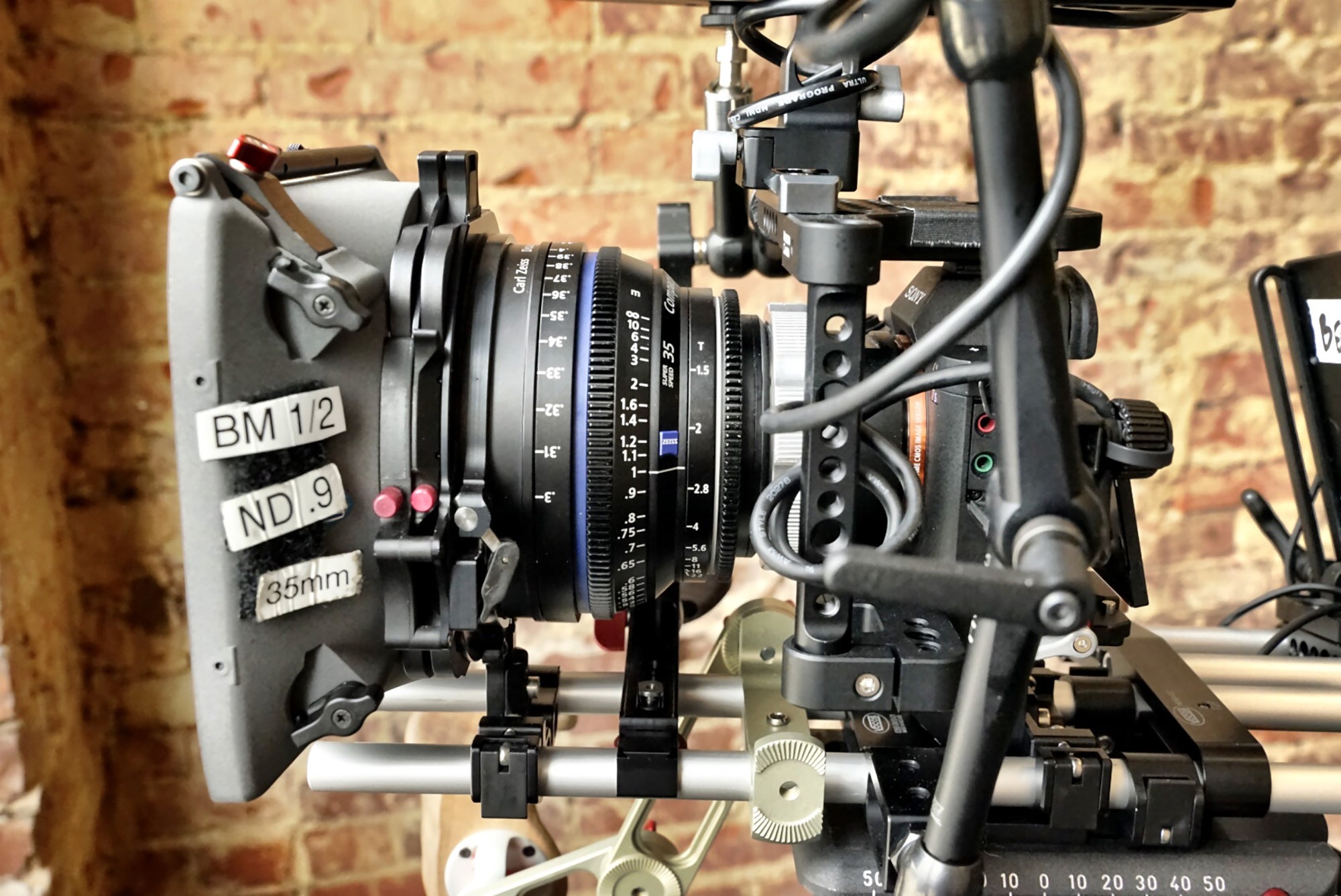 Above: Side view of the Sony α7S II on the set for Anathema showing lens length and filtration on the side of the matte box.
Above: Side view of the Sony α7S II on the set for Anathema showing lens length and filtration on the side of the matte box.
Both the α7R II and α7S II are 4K-capable cameras - recording internal to SDXC cards in the XAVCS codec. My first choice, however, is to record my 4K projects externally to my Atomos Shogun 4K monitor and recorder. The Shogun and its sister unit, the HDMI-only Ninja Assassin, record in a high-bitrate ProRes the uncompressed 4k signal that the cameras output via their micro-HDMI ports. Of course, on both films we wanted 4K acquisition so this was the system we used.
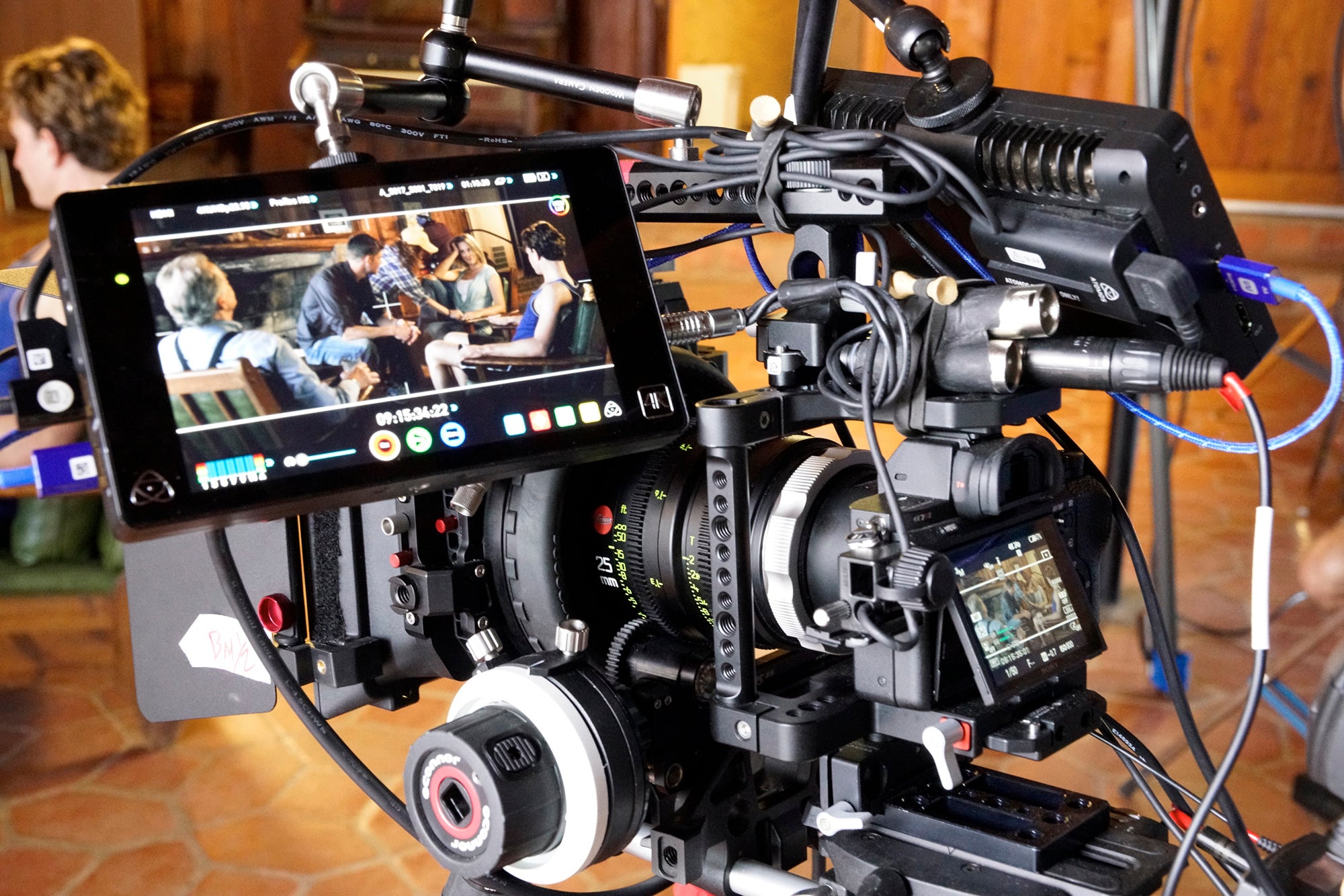 Above: The Sony α7R II on location in Mineral Wells, TX. Leica Summicron-C cinema lens. Atomos Shogun and Atomos NinjaAssassin as 1st AC monitor. Oconnor camera support, matte box and follow focus. Power by Anton Bauer V-mount batteries. Wooden Camera camera cage.
Above: The Sony α7R II on location in Mineral Wells, TX. Leica Summicron-C cinema lens. Atomos Shogun and Atomos NinjaAssassin as 1st AC monitor. Oconnor camera support, matte box and follow focus. Power by Anton Bauer V-mount batteries. Wooden Camera camera cage.
Diving Down The Cinema Rabbit Hole, Or My First Days at the Sony DMPC
Without doubt, my perspective on what Alpha series cameras are capable of is influenced by my experiences shooting with the F55, and just getting to the point that I was able to do that was, for a dyed-in-the-wool still photographer, a bit of a bear. Sure, in the time leading up to The Locksmith I had directed and shot a series of video projects for various commercial clients, but on those I surrounded myself with a crack crew that technically supported my creative vision. Stepping into the role of a proper cinematographer who could trade in the currency of motion pictures…that was different.
In fact, when I started down this path a couple of years ago, I had no idea what an F55 was. So I spent a few days attending classes at Sony’s DMPC, or Digital Motion Picture Center, at Sony Pictures Studios in Culver City, Los Angeles. Back in 1924, the Sony Pictures Studios lot was MGM Studios and then later, Columbia Pictures, so as I meandered the studio’s narrow passageways to Stage 7, home of the DMPC, I passed between nondescript sound stages where films like The Wizard of Oz, Gone with the Wind and Singin’ in the Rain were shot. I couldn’t think of a better setting for my new foray into cinematography.
It just so happened that my first class at the DMPC focused on the Sony F65. When I signed up for this broad-stroke overview class covering the basics of Sony’s flagship, 8K motion picture camera, I thought, Cool, this will give me a great intro into how these cameras work. I mean, I’ve been to many film and TV sets so I’ve been around this stuff before – this should be a breeze.
And really, I thought, f-stop, ISO, focal length, shutter angle or shutter speed, insert the memory card and go… how different can this F65 be, really, from what I’m used to with my DSLR cameras and what I learned on those film sets?
I couldn’t have been more wrong.
Once the F65 class began and DMPC instructor Keith Vidger launched into what makes the Sony F65 the Sony F65, I was lost almost immediately. Color Gamut? ITU-709? XAVC? Waveform? S-Log2? S-Gamut? Gamma? LUT? Baked in? Crushed blacks? ACES Color Management? Proxy files? 4:2:2? 4:4:4? XDCAM? Vector scope? Debayer?
Holy hell! Keith might as well have been speaking Medieval Dutch. I sat there completely, utterly, totally lost, afraid to even ask a question since it seemed everyone else in the room spoke this odd language. I realized very quickly that this material was way over my head. I left the F65 class that day humbled; I had so much to learn.
Leaning Into It and Gaining Control Over The Firehose
So I went back to the DMPC another day for my first F55 class. As I sat through this second class, I decided to call the DMPC, “The Firehose,” because that’s what this deluge of information felt like. There was just so much material to absorb. So much technical minutiae that was totally relevant to my learning how to understand, operate, and support the camera I was using on The Locksmith, and it was coming at me in a torrent, so it seemed.
But I endured. I wanted to understand the F55 completely. I wanted to get the camera and its technology dialed in to the point that it disappeared in my hands and I could focus completely on the creative. I wanted the F55 to become, for me, just another tool like all my other work cameras, my Sony Alpha series cameras and my lenses. I don’t think about how to use them, I just do. I wanted the same with the F55.
I drove home after that F55 class in shock at the disparity between the technical sides of cinematography and still photography. These cameras and their operation and workflow seemed so technically different from what I was used to with my DSLRs that I was completely taken aback. The reality of successfully navigating my way into this brave new world seemed very distant.
So I decided that finding similarities in cinematography to the world from which I came would be the key to my transition to creating literate moving images.
Getting Through The Technical To Focus On The Vision Or DMPC, Takes 3 and 4
To this end, I affirmed that I wasn’t ever going to be concerned about the nuts and bolts of constructing shots. I know and trust my eye and my aesthetic sensibility. I understand light and how to light. I understand emotion and translating that in the frame. I have tons of experience directing fashion models and celebrities during photo shoots. And after many years shooting for prestigious luxury brands and magazines, I know what looks good and what doesn’t. But I also realized that I needed help making this transition to motion, because I found that there were other concerns that a still photographer would never encounter, like eyelines and the 180 degree rule. I needed Cinematographer 101 stat.
So I called a friend.
This friend happens to be a seasoned DP who has shot some well-known films, and his mentoring was transformative. His advice, tips and encouragement were invaluable, both getting me past my barely-101-level understanding of cinematography, and getting me thinking maybe it wasn’t as ridiculous as it sounded for me to shoot The Locksmith.
I attended classes at Sony’s DMPC two more times. I hit the F55 class a second time, and then the DMPC’s Digital Tech course, which was imperative. One of my biggest concerns in supporting the camera on location was workflow and data management. 4K RAW files aren’t exactly small, and I wanted to know exactly what I was getting into, since it was looking like within a few short weeks, I would be on location, F55 in hand, shooting a movie.
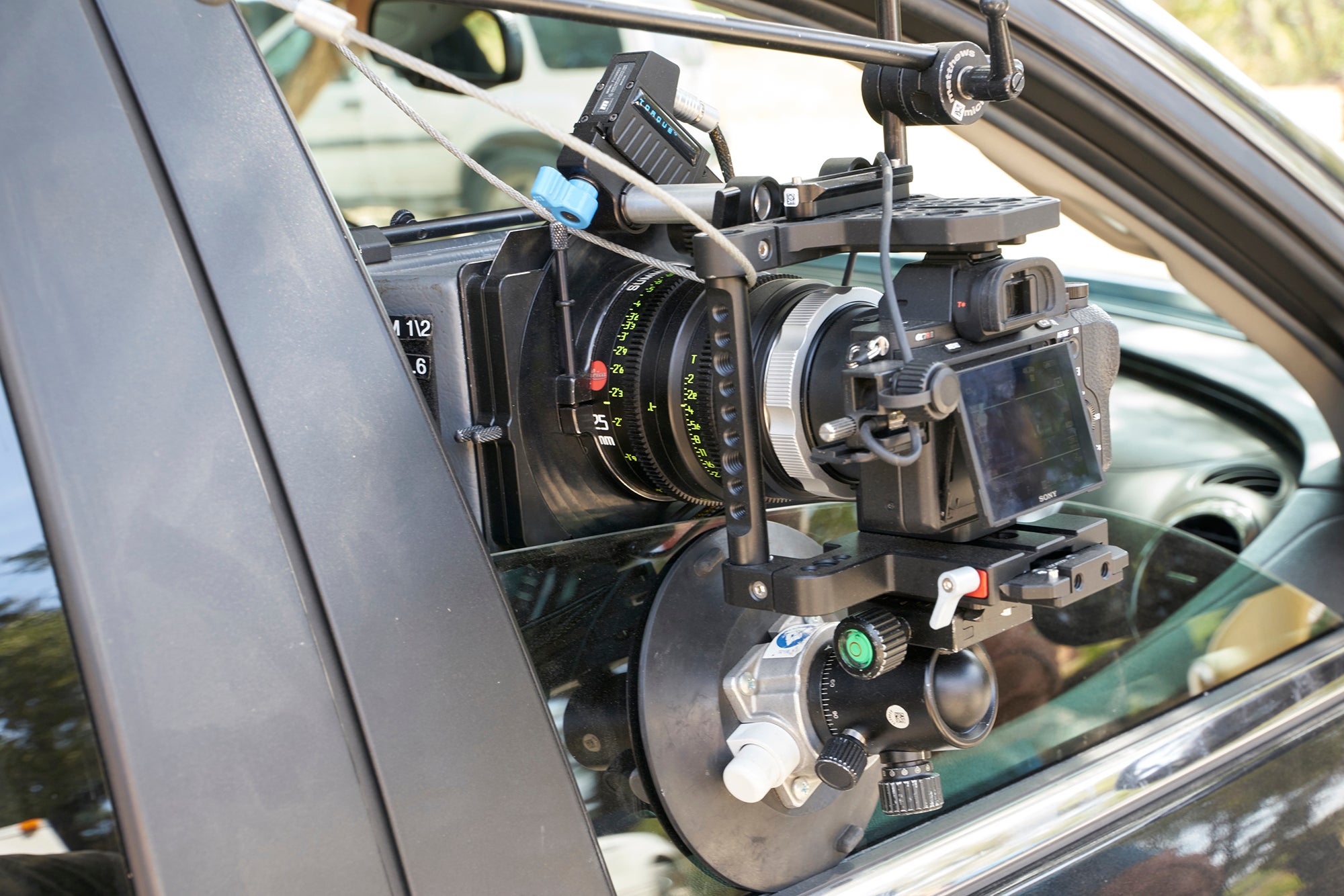 Sony α7R II in position for the car shot. Leica Summicron-C 25mm lens. Redrock Micro remote follow focus. Wooden camera PL to E lens adapter and camera cage. Out of frame is Atomos Shogun 4K recorder / monitor.
Sony α7R II in position for the car shot. Leica Summicron-C 25mm lens. Redrock Micro remote follow focus. Wooden camera PL to E lens adapter and camera cage. Out of frame is Atomos Shogun 4K recorder / monitor.
Why did I want to shoot in 4K RAW, which tops off a 512GB memory card in 66 minutes at 24P? Because as I was getting up to speed and finally comprehending the material, I realized that shooting in RAW offered myriad benefits. First, shooting RAW was directly translatable to my experience shooting RAW on my still cameras. And RAW and the S-Log2 or S-Log3 gamma curve I would also select would give me the post production flexibility, and resulting image quality, I demand, just like my still cameras.
Shooting in RAW and the S-LOG2 or S-Log3 gamma curve would allow me to harness the full, 14 stop dynamic range the sensor is capable of. Shooting in RAW and S-Log would give me the most exposure latitude. And since we were planning to shoot The Locksmith on a mostly overnight schedule, often in low light, a wide exposure latitude was critical. The F55’s S-Gamut color space is marginally wider than print film, and shooting in RAW and S-Log was the best way for me to record this wider color space. And finally, I wanted to shoot 4K to not only future proof the film for a longer shelf life, but also to allow for higher quality compositing and increased framing flexibility in post production.
Cue The Mirrorless Or How The Best Of The F55 Stars In The α7S II and α7R II
So I went and shot The Locksmith, had a great time—it’s currently in post production. And with the launch of the Alpha mirrorless line of cameras, a funny thing happened on the way to the internet forums. Some of the best technology that I used on the F55 trickled down to the α7S and carried forward into the α7R II and α7S II.
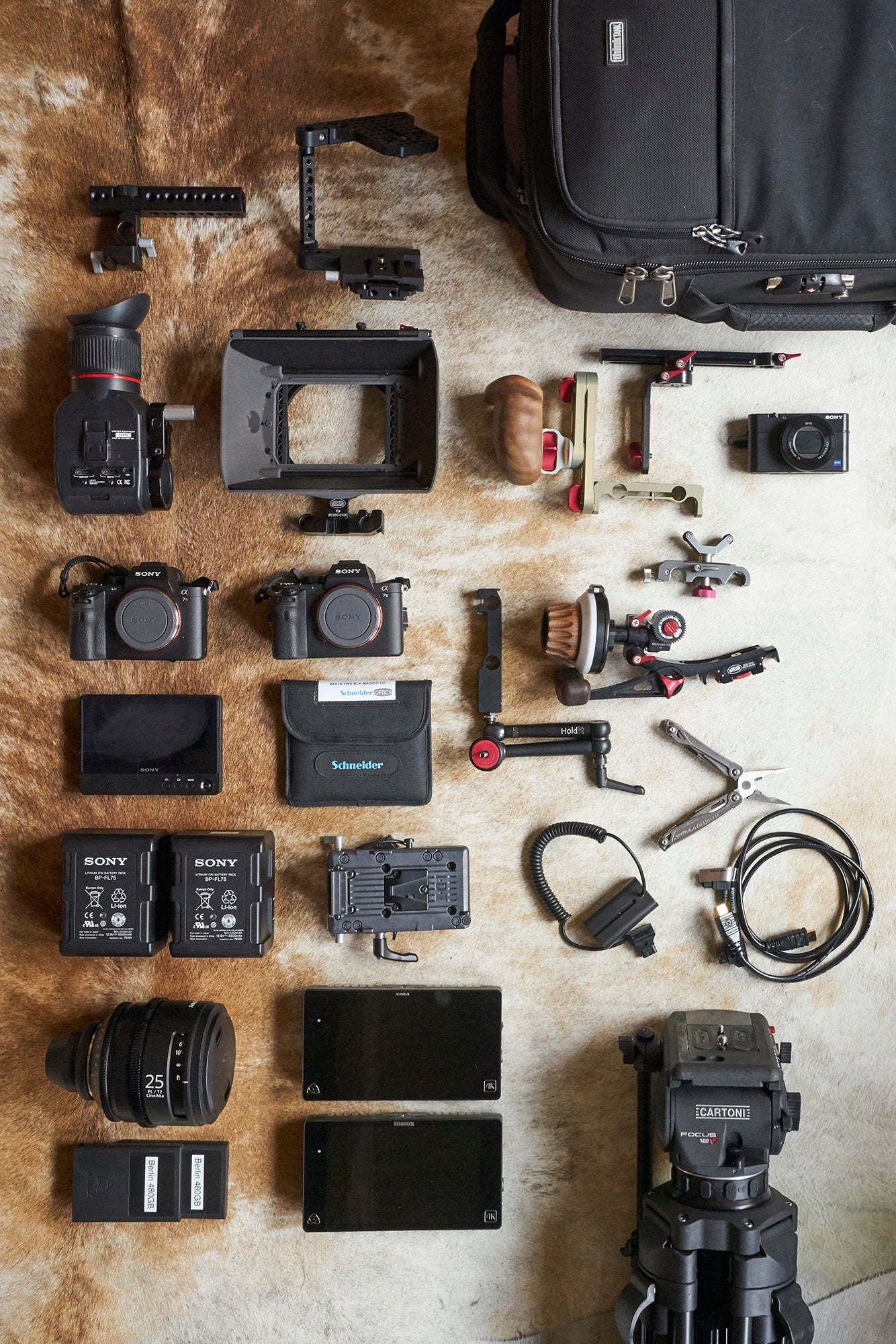 Above: What's In My Kit? Think Tank Airport International V2 bag. Wooden Camera camera cage. Kinotehnik EVF, Vocas matte box, Vocas wooden handgrip, Vocas EVF bracket, Sony RX100IV, Sony α7R II, Sony α7S II, Noga arm, Tilta lens support, Vocas follow focus, Sony 5” HD monitor, Schneider Hollywood Black Magic 1/2 4x4 filter, Leatherman tool, Sony BP-FL75 V-mount batteries, Wooden Camera V-mount battery plate, Switronix P-Tap to Sony NP cable, HDMI cable, Sony PL mount cinema lens, Atomos Shoguns, Cartoni Focus 12 tripod, Sandisk 480GB SSD drives.
Above: What's In My Kit? Think Tank Airport International V2 bag. Wooden Camera camera cage. Kinotehnik EVF, Vocas matte box, Vocas wooden handgrip, Vocas EVF bracket, Sony RX100IV, Sony α7R II, Sony α7S II, Noga arm, Tilta lens support, Vocas follow focus, Sony 5” HD monitor, Schneider Hollywood Black Magic 1/2 4x4 filter, Leatherman tool, Sony BP-FL75 V-mount batteries, Wooden Camera V-mount battery plate, Switronix P-Tap to Sony NP cable, HDMI cable, Sony PL mount cinema lens, Atomos Shoguns, Cartoni Focus 12 tripod, Sandisk 480GB SSD drives.
For example, the α7S II features, in Picture Profile 8, the option to record in the S-Log3 gamma curve. If we shoot at the camera’s native ISO, this gamma curve gives us the absolute widest dynamic range the camera’s imaging sensor is capable of. S-Log3 also offers more headroom in the highlights. The S-Gamut color space is now also available on my a7S-series and a7R II cameras. So combine the option to shoot in this color space with S-Logs 2 and 3 capability and this camera is starting to look like a bona fide digital cinema camera.
As many of us know from experience, Log curves are flat profiles which are low on contrast and desaturated. As such, one really doesn’t want to monitor in such a color space. New with the α7S II is a handy feature called Gamma Display Assist. This feature acts just like a monitor LUT one might load onto the Atomos Shogun or F55, converting the flat, low-contrast look of S-Log to the pop of a 709 color space. Other features helpful to videographers and filmmakers are also present. Of course, the native Sony lenses, whether Sony/Zeiss or Sony G, are excellent, but the flexibility to adapt just about any lens for use on the Alpha mirrorless cameras has been a game changer, especially for filmmakers who want to use the kind of specialized cinema lenses with their cameras. There’s focus peaking and zebra, which are terrific aids for focus and exposure, and the very high quality electronic viewfinder, which allows one to take full advantage of these added features.
And finally, Sony recently released a new firmware update for the α7R II and α7S II cameras that solves the heating issues some saw during internal 4K recording.
At the end of the day, when the rubber meets the runway, the most important things to me are image quality, ergonomics, workflow and reliability.
After coming off a rather busy few months shooting two feature films on the α7S II and α7R II, I’m pretty blown away by what is now possible with these compact, mirrorless cameras. These cameras not only give me an image quality that cuts together very well with other, higher-end cinema cameras, but also, due to Sony’s long legacy in film and broadcast, they are packed to the gills with features that make it easier to create world-class level content. This is a great time to be a filmmaker.
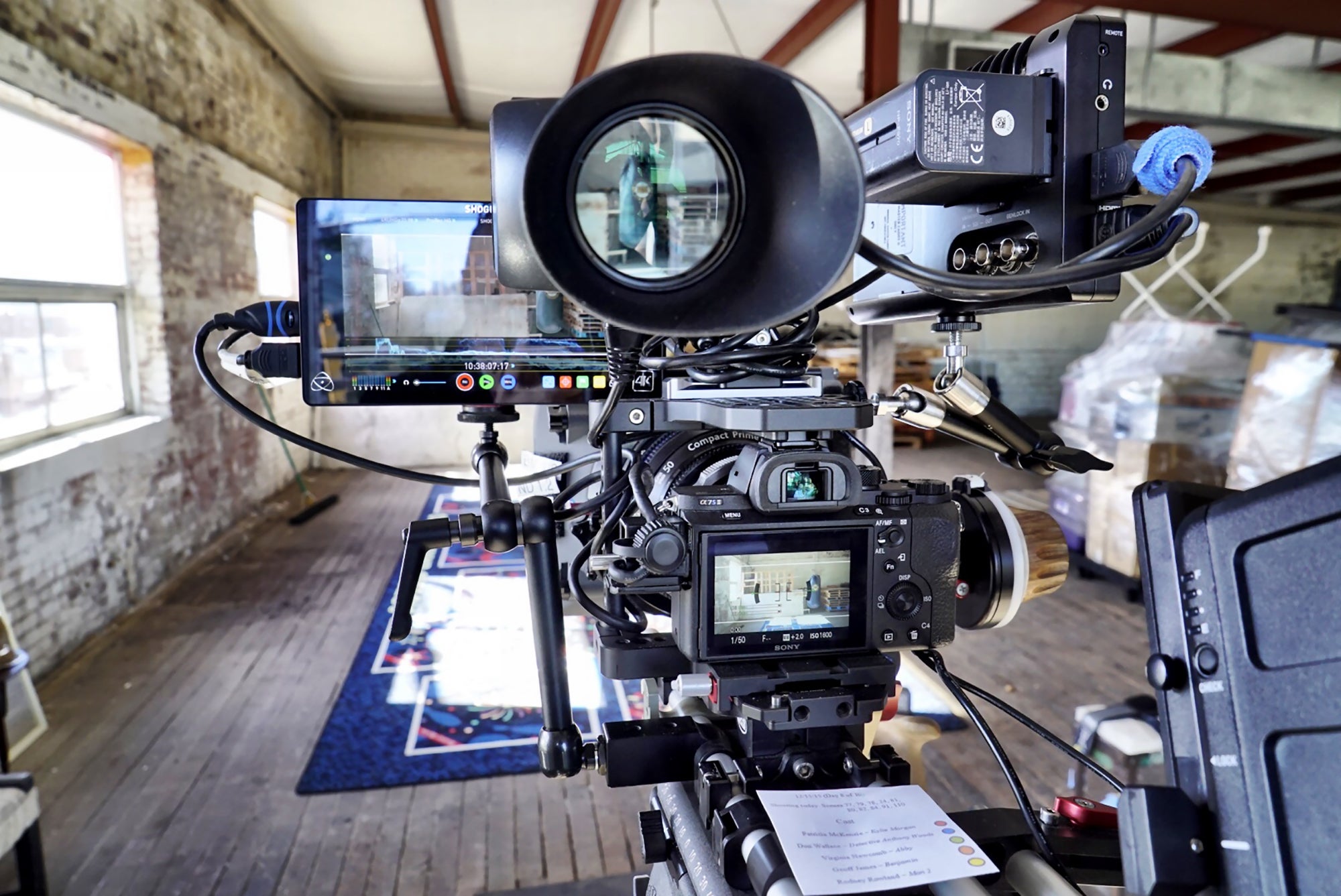 Above: Shooter’s view of the Sony α7S II on location in Dalton, GA. Zeiss CP.2 Super Speed cinema lens, 2x Atomos Shogun, Kinotehnik EVF, Wooden Camera cage, Sony V-mount battery, Vocas follow focus and matte box, Cartoni camera support.
Above: Shooter’s view of the Sony α7S II on location in Dalton, GA. Zeiss CP.2 Super Speed cinema lens, 2x Atomos Shogun, Kinotehnik EVF, Wooden Camera cage, Sony V-mount battery, Vocas follow focus and matte box, Cartoni camera support.



